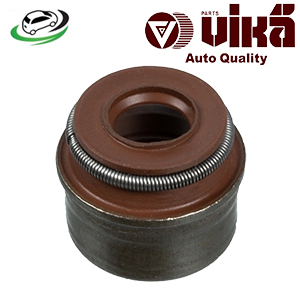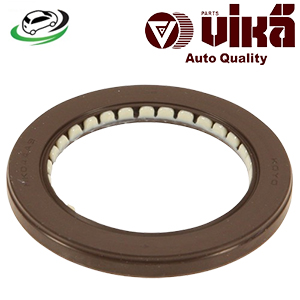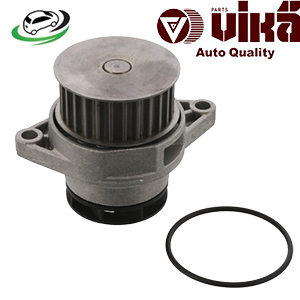-15%
Get Water Pump Volkswagen Polo III (6N1) 1994/10-1999/10 36121005
The water pump is a critical component in an internal combustion engine’s cooling system. It ensures that coolant circulates through the engine, radiator, and heater core, maintaining optimal operating temperatures and preventing overheating. Understanding the functionality, types, components, signs of failure, and maintenance of a water pump is crucial for anyone involved in automotive repair or engine maintenance.
Functionality of the Water Pump
The primary function of a water pump is to circulate coolant through the engine and cooling system. This circulation helps to:
- Regulate Temperature: By moving coolant through the engine block and cylinder head, the water pump helps absorb and dissipate heat, maintaining the engine at an optimal temperature.
- Prevent Overheating: Effective circulation of coolant prevents localized hot spots and overheating, which can cause engine damage.
- Enhance Heater Performance: By circulating hot coolant through the heater core, the water pump also aids in providing heat to the vehicle’s cabin.
Components of a Water Pump
A typical water pump consists of several key components:
- Impeller: The impeller is a rotor located inside the pump housing. As it spins, it pushes coolant through the engine and radiator.
- Housing: The housing encases the impeller and provides a pathway for coolant flow.
- Shaft and Bearings: The impeller is mounted on a shaft supported by bearings, allowing it to spin smoothly.
- Pulley: The pulley is attached to the shaft and driven by the engine’s drive belt, timing belt, or timing chain.
- Seals and Gaskets: Seals and gaskets prevent coolant from leaking out of the pump housing.
Types of Water Pumps
Water pumps come in various types, each suited to different engine designs and performance requirements:
- Mechanical Water Pumps: These are the most common type, driven by the engine’s drive belt, timing belt, or timing chain. As the engine runs, the pump impeller spins, circulating coolant.
- Electric Water Pumps: Electric water pumps are driven by an electric motor rather than the engine. They offer greater control over coolant flow and can operate independently of engine speed, improving efficiency and performance.
- Auxiliary Water Pumps: These are secondary pumps used in some vehicles to provide additional coolant flow to specific areas, such as the turbocharger or rear heater core.
Signs of a Failing Water Pump
Recognizing the signs of a failing water pump is crucial for preventing engine overheating and damage:
- Coolant Leaks: Visible coolant leaks under the vehicle, especially near the front, may indicate a failing water pump. Leaks can result from worn seals, gaskets, or housing.
- Overheating: If the engine temperature rises above normal levels, it may be due to a malfunctioning water pump that is not circulating coolant effectively.
- Whining or Grinding Noise: Unusual noises from the front of the engine may indicate worn bearings in the water pump.
- Steam or Smoke: Steam or smoke coming from the engine bay can be a sign of a severe coolant leak or overheating issue.
- Corroded or Damaged Impeller: Over time, the impeller can become corroded or damaged, reducing its ability to circulate coolant effectively.
Maintenance and Replacement
Proper maintenance of the water pump involves regular inspections and timely replacements to ensure optimal engine performance and longevity:
- Regular Inspections: Periodically inspect the water pump and surrounding area for signs of leaks, corrosion, or damage.
- Monitor Coolant Levels: Keep an eye on coolant levels and top off as necessary. A sudden drop in coolant levels may indicate a leak.
- Listen for Noises: Pay attention to any unusual noises coming from the front of the engine, particularly whining or grinding sounds.
- Replace Timing Belt/Chain: If the water pump is driven by the timing belt or chain, it is often recommended to replace the water pump simultaneously during timing belt/chain replacement intervals.
- Flush Coolant System: Periodically flush and replace the coolant to prevent corrosion and maintain the cooling system’s efficiency.
Replacement Process
Replacing a water pump involves several steps and may vary depending on the vehicle’s make and model:
- Drain Coolant: Begin by draining the coolant from the radiator and engine block.
- Remove Drive Components: Remove the drive belt, timing belt, or timing chain cover, depending on the water pump’s drive mechanism.
- Remove Old Water Pump: Unbolt and remove the old water pump, taking care to clean the mounting surface.
- Install New Water Pump: Install the new water pump, ensuring it is properly seated and sealed with new gaskets or seals.
- Reassemble Components: Reinstall the drive components, timing belt, or timing chain cover, and fill the cooling system with fresh coolant.
- Bleed Air from System: Bleed any air from the cooling system to prevent air pockets that can cause overheating.
Importance of Quality Water Pumps
Using high-quality water pumps is essential for several reasons:
- Performance: Quality pumps ensure efficient coolant circulation, maintaining optimal engine temperature.
- Durability: High-quality materials and construction enhance the pump’s longevity, reducing the frequency of replacements.
- Reliability: A reliable water pump reduces the risk of overheating and associated engine damage.
- Cost-Effectiveness: Investing in a quality water pump can prevent costly repairs due to overheating and engine damage.
Follow us on Facebook for more parts.



